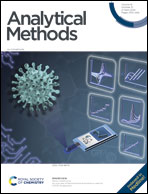A complementary method with PFBBr-derivatization based on a GC-EI-MS platform for the simultaneous quantitation of short-, medium- and long-chain fatty acids in murine plasma and feces samples†
Abstract
Fatty acids (FAs) are essential molecules in all organisms and are involved in various physiological and pathophysiological processes. Pentafluorobenzyl bromide (PFBBr) is commonly used for FA derivatization for gas chromatography-mass spectrometry (GC-MS) quantification by chemical ionization (CI). While CI is the conventional ionization mode for PFBBr derivatization, the electron ionization (EI) source has also demonstrated efficacy in achieving satisfactory analytical performance for the analysis of PFB esters. In this study, we present a novel approach utilizing PFBBr-derivatization on a GC-EI-MS platform to quantitatively analyze a comprehensive range of 44 fatty acids (FAs) spanning from C2 to C24. The method's sensitivity, precision, accuracy, linearity, recovery, and matrix effect were rigorously validated against predetermined acceptance criteria. In comparison to the conventional CI ionization mode, the utilization of PFBBr-derivatization in GC-EI-MS exhibits a wider range of applications and achieves comparable sensitivity levels to the conventional CI platform. By using this method, we successfully quantified 44 FAs in plasma and feces samples from the mice with deoxynivalenol (DON)-induced kidney injury. Among these, the levels of most FA species were increased in the DON-exposure group compared with the control group. The orthogonal partial least squares discriminant analysis (OPLS-DA) of all the tested FAs showed a visual separation of the two groups, indicating DON exposure resulted in a disturbance of the FA profile in mice. These results indicate that the established method by integration of GC-MS with PFBBr derivatization is an efficient approach to quantify the comprehensive FA profile, which includes short-, medium- and long-chain FAs. In addition, our study provides new insights into the mechanism underlying DON exposure-induced kidney injury.



 Please wait while we load your content...
Please wait while we load your content...